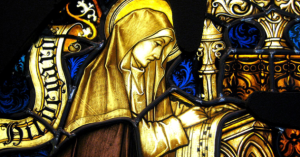
Saint Hildegard of Bingen –Image Courtesy: UCatholic@Twitter
(Franciscan Media) Abbess, artist, author, composer, mystic, pharmacist, poet, preacher, theologian–where to begin describing this remarkable woman?
Born into a noble family, she was instructed for 10 years by the Holy Woman Blessed Jutta–When Hildegard was 18 she came a Benedictine Nun at the Monastery of Saint Disbodenberg.
Ordered by her confessor to write down the visions she received since the age of 3, Hildegard took 10 years to write her ‘Scivias’ (Know the Ways) Pope Eugene III read it and in 1147 encouraged her to continue writing.
Hildegard’s book of ‘The Merits of Life and Book of Divine Works’ followed, wring over 300 letters to people who sought her advice–later she also composed short works on medicine, physiology and sought advice from contemporaries such as St. Bernard of Clairvaux.
Saint Hildegard’s visions caused her to see humans as “living sparks” of God’s love, coming from God as daylight comes from the sun. Sin destroyed the original harmony of creation. Christ’s redeeming death and resurrection opened up new possibilities. Virtuous living reduces the estrangement from God and others that sin causes.
Hildegard saw the harmony of God’s creation and the place of Women and Men in that. This unity was not apparent to many of her contemporaries.
In September 2010, Pope Benedict spoke about ‘Hildegard of Bingen’ during two general audiences, praising her humility with which she received God’s gifts the obedience she gave Church authorities. Pope Benedict praised the “rich theological content” of her mystical visions that sum up the history of salvation from creation to the end of time.
In 2012 Hildegard was Canonized and named a ‘Doctor of the Church’ by Pope Benedict XVI
Related: Apostolic Letter (2012) by Pope Benedict XVI, Proclaiming Hildegard of Bingen, Doctor of the Church